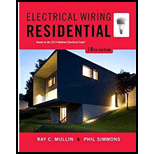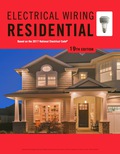
Electrical Wiring: Residental - With Plans (Paperback) Package
18th Edition
ISBN: 9781305416376
Author: MULLIN
Publisher: Cengage
expand_more
expand_more
format_list_bulleted
Concept explainers
Question
Chapter 25.3, Problem 6R
a.
To determine
Find the operating voltage of residence chimes.
b.
To determine
How the rated voltage for chimes can be obtained.
Expert Solution & Answer
Want to see the full answer?
Check out a sample textbook solution
Students have asked these similar questions
DO NOT WANT AI WILL REJECT
DO NOT NEED AI WILL REJECT
1
6. Root locus for a closed-loop system with L(s)
is shown below.
s(s+4)(s+6)
Chapter 25 Solutions
Electrical Wiring: Residental - With Plans (Paperback) Package
Ch. 25.1 - How many television outlets are installed in this...Ch. 25.1 - Which type of television cable is commonly used...Ch. 25.1 - What determines the design of the faceplates used?...Ch. 25.1 - Prob. 4RCh. 25.1 - From a cost standpoint, which system is more...Ch. 25.1 - Prob. 6RCh. 25.1 - Prob. 7RCh. 25.1 - Prob. 8RCh. 25.1 - Which article of the Code references the...Ch. 25.1 - It is generally understood that grounding and...
Ch. 25.1 - Prob. 11RCh. 25.1 - Prob. 12RCh. 25.1 - Which section of the Code prohibits supporting...Ch. 25.1 - When hooking up one CATV cable and another cable...Ch. 25.1 - Prob. 15RCh. 25.1 - Prob. 16RCh. 25.2 - How many locations are provided for telephones in...Ch. 25.2 - At what height are the telephone outlets in this...Ch. 25.2 - Sketch the symbol for a telephone outlet.Ch. 25.2 - Is the telephone system regulated by the NEC?...Ch. 25.2 - a. Who is to furnish the outlet boxes required at...Ch. 25.2 - Who is to furnish the telephones? _____Ch. 25.2 - Who does the actual installation of the telephone...Ch. 25.2 - How are the telephone cables concealed in this...Ch. 25.2 - Prob. 9RCh. 25.2 - What are the colors contained in a four-conductor...Ch. 25.2 - Itemize the code rule for the installation of...Ch. 25.2 - If finger contact were made between the red...Ch. 25.2 - What section of the Code prohibits supporting...Ch. 25.2 - The term cross-talk is used to define the hearing...Ch. 25.2 - Which section of the Code prohibits telephone...Ch. 25.3 - Prob. 1RCh. 25.3 - What style of chime is used in this residence?...Ch. 25.3 - a. How many solenoids are contained in a 2-tone...Ch. 25.3 - Explain briefly how two notes are sounded by...Ch. 25.3 - a. Sketch the symbol for a push button....Ch. 25.3 - Prob. 6RCh. 25.3 - What is the maximum volt-ampere rating of...Ch. 25.3 - What two types of chime transformers for Class 2...Ch. 25.3 - Is the extension chime connected with the front...Ch. 25.3 - a. What change in equipment may be necessary when...Ch. 25.3 - What type of insulation is usually found on...Ch. 25.3 - Prob. 13RCh. 25.3 - a. How many wires are run between the front hall...Ch. 25.3 - Why is it recommended that the low-voltage...Ch. 25.3 - a. Is it permissible to install low-voltage Class...Ch. 25.3 - a. Where is the transformer in the residence...Ch. 25.3 - a. How many feet of 2-conductor bell wire cable...Ch. 25.3 - Prob. 19RCh. 25.3 - Prob. 20RCh. 25.3 - What section of the Code prohibits supporting fire...Ch. 25.3 - Prob. 22RCh. 25.3 - What does the term Wi-Fi stand for? _____Ch. 25.3 - A Wi-Fi system is (required) (optional). (Circle...
Knowledge Booster
Learn more about
Need a deep-dive on the concept behind this application? Look no further. Learn more about this topic, electrical-engineering and related others by exploring similar questions and additional content below.Similar questions
- DO NOT NEED AI WILL REJECTarrow_forward5. Sketch the root locus for L(s) = s+10 using rules 1, 2, and 4. For rule 4, you need to s(s+6) find the break-in and break-away points.arrow_forwardS+4 4. Sketch the root locus for L(s) = (s+6) (s+1)2 using rules 1, 2, and 3. For rule 3, you need to find the value of σ and a for the asymptotes. From the root-locus, explain why the closed-loop system is always stable for any choice of the design parameter K in the range 0 < K < ∞o.arrow_forward
- 2. Consider the following system. K(s+3) (s+4) (s+1)(s+2) Check whether the points below are in the root locus. If the point is in the root locus, then also find what the corresponding gain K. i) ii) -2+j3 -2+1√ √ Hint: First find L(s). Next, in L(s) replace s with the value of the point and then express it in polar format r20 using calculator. The point will be in the root locus if and only if = 180° or odd multiple of 180°. When the point is in the root locus, the corresponding gain K is obtained as K ==arrow_forwardsolve and show workarrow_forwardDesign and find values. please solve ASAP (it's for practice before an exma, I don't have time)arrow_forward
- Can you show why the answer is that for this question using second order differential equations, instead of laplace transformsarrow_forward2. For each of the following transfer functions, G(s) = Y(s)/U(s), find the differential equation relating the input u(t) to the output y(t). (s+2)(s+3) (a) G(s) = (s+1)(s+4) (s²+0.4s+1.04) (s+3) (b) G(s)= (s2+0.2s+1)(s+2)(s+4)arrow_forwardDon't use ai to answer I will report you answerarrow_forward
- 5. A schematic diagram of a motor connected to a load by gears is shown. Both the motor and the load are modeled as rotating masses with viscous damping. Find the transfer functions Øm/Tm and ØL/Tm. bm Jm Tm 0m N₂ N₁ OL но JL b₁arrow_forward3. Find the transfer function X2/F of the mechanical system in Figure. Κι www b₁ M₁ K2 www M2 b2 X2 F b3arrow_forwardS1(t) Es/Ts 0 S3(t) 0 Es/Ts Ts t S2(t) Es/Ts 0 Es/Ts Ts |7|2 S4(t) Es/Ts t Ts t 0 Ts Ts Ts Es/TS 2 1/ Q1(t) 42(t) Ts 1JT 0 t 0 Ts Ts 2 32 FIGURE 7.3 Set of signals and orthonormal functions for Example 7.1. 53(t)=√√Esq₁(t) S4(t)=-√E542(t) t Tsarrow_forward
arrow_back_ios
SEE MORE QUESTIONS
arrow_forward_ios
Recommended textbooks for you
 EBK ELECTRICAL WIRING RESIDENTIALElectrical EngineeringISBN:9781337516549Author:SimmonsPublisher:CENGAGE LEARNING - CONSIGNMENT
EBK ELECTRICAL WIRING RESIDENTIALElectrical EngineeringISBN:9781337516549Author:SimmonsPublisher:CENGAGE LEARNING - CONSIGNMENT

EBK ELECTRICAL WIRING RESIDENTIAL
Electrical Engineering
ISBN:9781337516549
Author:Simmons
Publisher:CENGAGE LEARNING - CONSIGNMENT